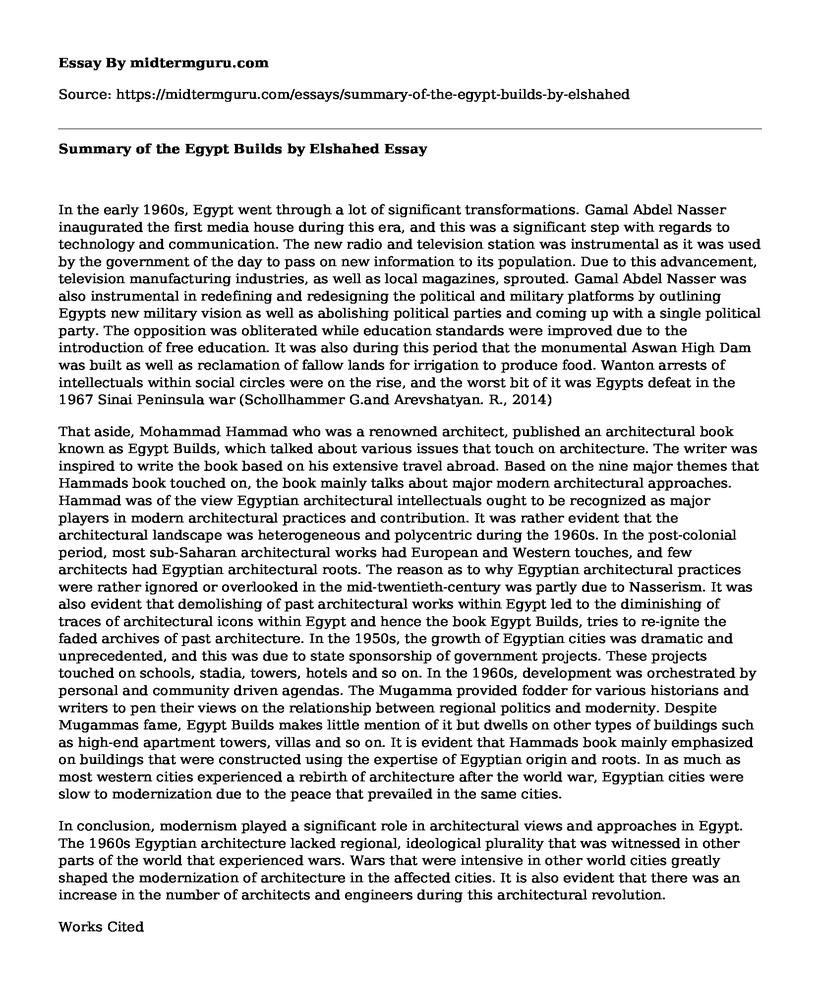In the early 1960s, Egypt went through a lot of significant transformations. Gamal Abdel Nasser inaugurated the first media house during this era, and this was a significant step with regards to technology and communication. The new radio and television station was instrumental as it was used by the government of the day to pass on new information to its population. Due to this advancement, television manufacturing industries, as well as local magazines, sprouted. Gamal Abdel Nasser was also instrumental in redefining and redesigning the political and military platforms by outlining Egypts new military vision as well as abolishing political parties and coming up with a single political party. The opposition was obliterated while education standards were improved due to the introduction of free education. It was also during this period that the monumental Aswan High Dam was built as well as reclamation of fallow lands for irrigation to produce food. Wanton arrests of intellectuals within social circles were on the rise, and the worst bit of it was Egypts defeat in the 1967 Sinai Peninsula war (Schollhammer G.and Arevshatyan. R., 2014)
That aside, Mohammad Hammad who was a renowned architect, published an architectural book known as Egypt Builds, which talked about various issues that touch on architecture. The writer was inspired to write the book based on his extensive travel abroad. Based on the nine major themes that Hammads book touched on, the book mainly talks about major modern architectural approaches. Hammad was of the view Egyptian architectural intellectuals ought to be recognized as major players in modern architectural practices and contribution. It was rather evident that the architectural landscape was heterogeneous and polycentric during the 1960s. In the post-colonial period, most sub-Saharan architectural works had European and Western touches, and few architects had Egyptian architectural roots. The reason as to why Egyptian architectural practices were rather ignored or overlooked in the mid-twentieth-century was partly due to Nasserism. It was also evident that demolishing of past architectural works within Egypt led to the diminishing of traces of architectural icons within Egypt and hence the book Egypt Builds, tries to re-ignite the faded archives of past architecture. In the 1950s, the growth of Egyptian cities was dramatic and unprecedented, and this was due to state sponsorship of government projects. These projects touched on schools, stadia, towers, hotels and so on. In the 1960s, development was orchestrated by personal and community driven agendas. The Mugamma provided fodder for various historians and writers to pen their views on the relationship between regional politics and modernity. Despite Mugammas fame, Egypt Builds makes little mention of it but dwells on other types of buildings such as high-end apartment towers, villas and so on. It is evident that Hammads book mainly emphasized on buildings that were constructed using the expertise of Egyptian origin and roots. In as much as most western cities experienced a rebirth of architecture after the world war, Egyptian cities were slow to modernization due to the peace that prevailed in the same cities.
In conclusion, modernism played a significant role in architectural views and approaches in Egypt. The 1960s Egyptian architecture lacked regional, ideological plurality that was witnessed in other parts of the world that experienced wars. Wars that were intensive in other world cities greatly shaped the modernization of architecture in the affected cities. It is also evident that there was an increase in the number of architects and engineers during this architectural revolution.
Works Cited
M. Elshahed, Egypt Builds: A Reevaluation of the History of Modernism, in Sweet Sixties: Specters and Spirits of a Parallel Avant-Garde, edited by G. Schollhammer and R. Arevshatyan (Sternberg Press, 2014), pp. 137-149.
Cite this page
Summary of the Egypt Builds by Elshahed. (2021, May 25). Retrieved from https://midtermguru.com/essays/summary-of-the-egypt-builds-by-elshahed
If you are the original author of this essay and no longer wish to have it published on the midtermguru.com website, please click below to request its removal:
- Essay on Exxon Valdez Oil Spill
- Risk Assessment Case Study: Incidences in the Building
- Ecology Essay on Mountain Top Mining, Fracking, and Oil Spill
- Environmental Management for the Mining Industry - Essay Sample
- Engineering Management Admission - Essay Sample
- Network Analysis Approach for Optimal Project Execution in Engineering Industry - Research Paper
- Essay Sample on Process of Renovating and Rehabilitating a Building







